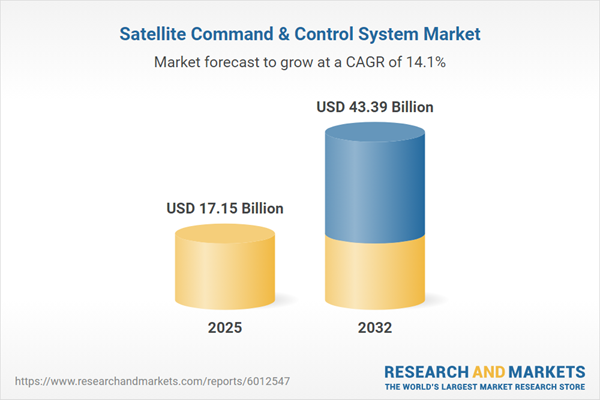Speak directly to the analyst to clarify any post sales queries you may have.
Senior decision-makers in the satellite command and control system market are navigating a climate defined by accelerating technological change and complex regulatory requirements. To remain competitive, leadership must drive innovation, build resilient operational strategies, and manage evolving compliance challenges within a highly interconnected ecosystem.
Market Snapshot: Satellite Command and Control System Market
The satellite command and control system market is experiencing robust growth, with a projected valuation of USD 15.05 billion in 2024, anticipated to reach USD 17.15 billion in 2025, and expanding further to USD 43.39 billion by 2032. This expansion is supported by a compound annual growth rate (CAGR) of 14.14%.
Growth momentum arises from rising adoption across commercial, defense, and research applications. Organizations are seeking cloud-enabled and AI-driven solutions to modernize operations, optimize resource allocation, and improve compliance response. Continuous investment in automation and network resilience is fueling operational effectiveness, while agile infrastructure strategies and new procurement models continue to shape the competitive landscape. Key industry participants set benchmarks for innovation and data security as the sector responds to increased digitalization and policy changes.Scope & Segmentation: Satellite Command and Control System Market
This analysis delivers targeted insights for executive stakeholders shaping market direction and organizational strategy. The following segmentation highlights the market’s core dimensions:
- End User: Commercial sectors emphasize agility and operational flexibility for satellite fleet management; government and defense prioritize robust system security for mission-critical performance; academic and research organizations explore new technology frontiers through pilot deployments; telecommunications stakeholders aim to extend coverage and ensure network reliability.
- Component: Hardware—such as antennas, modems, and control consoles—enables reliable physical infrastructure. Advanced software solutions support mission planning, telemetry, and operational data management, empowering operators to manage complex constellations efficiently.
- Deployment Model: Cloud-based approaches allow fast, scalable system configurations. Hybrid deployments enable organizations to balance compliance needs with integration efforts. On-premise deployment remains crucial for classified or sensitive projects, supporting information sovereignty and tailored control.
- Frequency Band: Use of C-Band, Ka-Band, Ku-Band, and X-Band allows tailored network performance for a range of regional and mission-specific demands, supporting diverse organizational requirements.
- Regional Coverage: Americas, Europe, Middle East and Africa, and Asia-Pacific feature distinct adoption trends influenced by local regulatory policies, funding priorities, and innovation programs. Regional variations impact both technology selection and system deployment pace, requiring localized market understanding.
- Key Organizations: Industry leaders—including Lockheed Martin Corporation, Airbus SE, Raytheon Technologies, Thales S.A., Northrop Grumman, The Boeing Company, L3Harris Technologies, BAE Systems, Honeywell International, and General Dynamics—drive sector advancements and establish operational standards.
Key Takeaways for Senior Decision-Makers
- AI and cloud integration simplify satellite command processes, enable faster and more informed decision-making, and reduce reliance on manual interventions for routine operations.
- Modular and open architecture system designs support rapid upgrades and adaptability, ensuring readiness for technological shifts and new mission requirements.
- End-to-end cybersecurity is embedded in modern solutions, providing robust defenses against evolving cyber threats and strengthening data protection strategies.
- Supply chain resilience is bolstered by diversified sourcing and strategic regional partnerships, helping organizations effectively manage regulatory changes and unexpected disruptions.
- Digital twin platforms and integrated operational analytics help streamline deployments, enhance fleet optimization, and drive long-term operational efficiency and reliability.
- Frequent technology and policy updates require a proactive approach to deployment planning, ensuring organizations remain agile and compliant as frameworks evolve.
Tariff Impact on Supply Chains
Ongoing U.S. tariff regulations influence supply chain decisions across the satellite command and control system market. Hardware providers are expanding localized and diversified sourcing approaches to maintain pricing stability and minimize compliance risks. Software vendors are forming regional alliances and tailoring solutions to current market needs and regulatory expectations. Procurement actions—particularly in defense, telecom, and academia—prioritize agility, risk mitigation, and responsiveness to changing policy conditions.
Methodology & Data Sources
This research leverages interviews with senior executives, patent landscape analysis, industry workshops, and comprehensive regulatory monitoring. By combining primary and secondary sources, the methodology ensures the report provides actionable intelligence for strategic planning in the satellite command and control system industry.
Why This Report Matters for Strategic Leaders
- Gain sector-specific insights to accelerate adoption of advanced technologies, strengthen operational integrity, and support large-scale organizational transformation in satellite command and control.
- Reduce procurement and compliance risks using up-to-date assessments of regulations and supply chain realignments relevant to the satellite command and control system market.
- Align modernization initiatives to market best practices, empowering executives to take proactive measures and meet global sector challenges with confidence.
Conclusion
This report enables strategic leaders to anticipate market shifts, manage evolving risks, and secure a lasting advantage in the satellite command and control system sector.
Additional Product Information:
- Purchase of this report includes 1 year online access with quarterly updates.
- This report can be updated on request. Please contact our Customer Experience team using the Ask a Question widget on our website.
Table of Contents
3. Executive Summary
4. Market Overview
7. Cumulative Impact of Artificial Intelligence 2025
Companies Mentioned
The companies profiled in this Satellite Command & Control System market report include:- Lockheed Martin Corporation
- Airbus SE
- Raytheon Technologies Corporation
- Thales S.A.
- Northrop Grumman Corporation
- The Boeing Company
- L3Harris Technologies, Inc.
- BAE Systems plc
- Honeywell International Inc.
- General Dynamics Corporation
Table Information
| Report Attribute | Details |
|---|---|
| No. of Pages | 190 |
| Published | October 2025 |
| Forecast Period | 2025 - 2032 |
| Estimated Market Value ( USD | $ 17.15 Billion |
| Forecasted Market Value ( USD | $ 43.39 Billion |
| Compound Annual Growth Rate | 14.1% |
| Regions Covered | Global |
| No. of Companies Mentioned | 11 |









